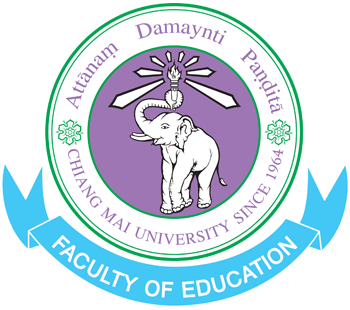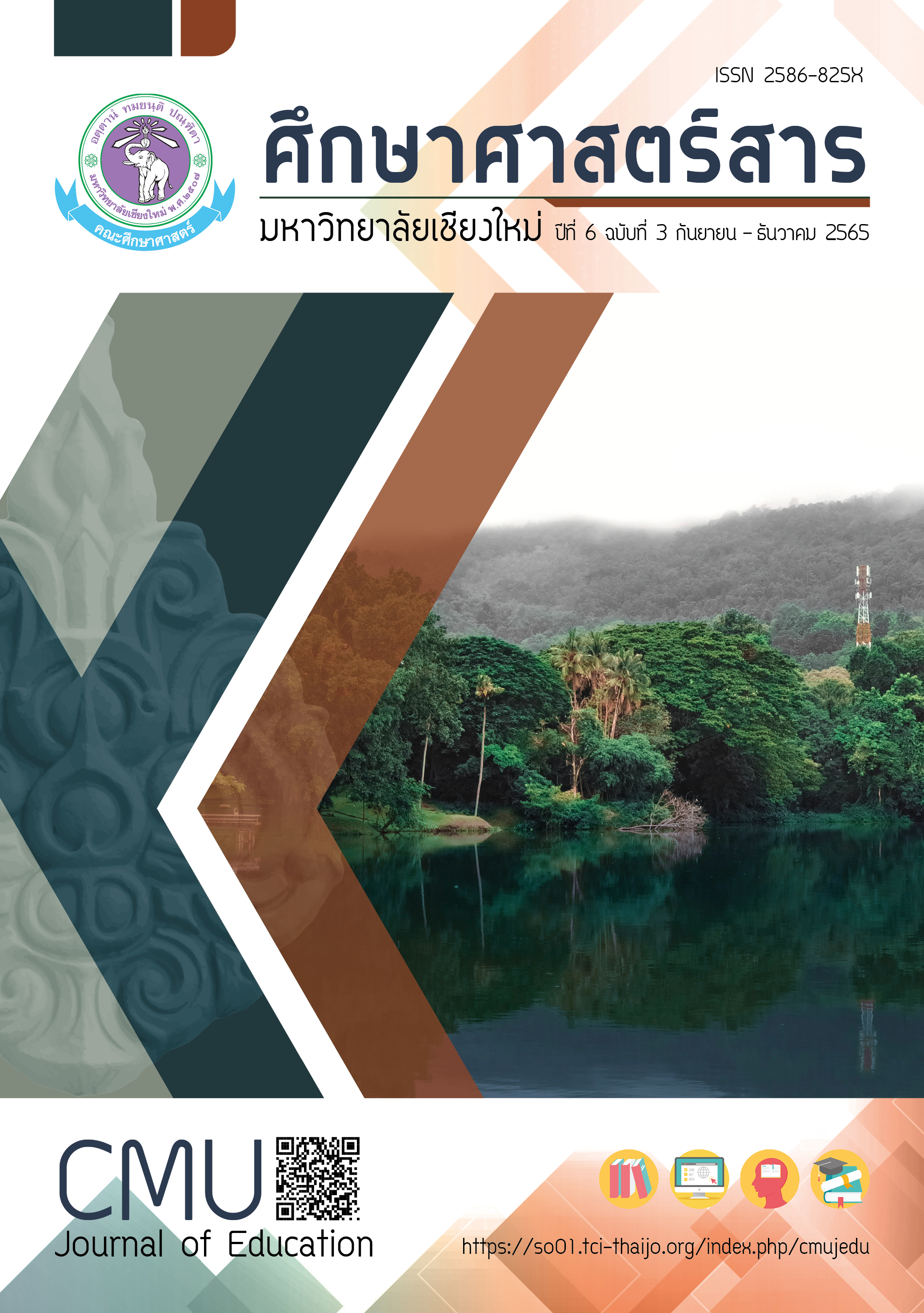การศึกษาความสัมพันธ์ระหว่างความเชื่อเกี่ยวกับการแก้ปัญหาทางคณิตศาสตร์และ แนวคิดเกี่ยวกับการสอนคณิตศาสตร์ของนักศึกษาครูคณิตศาสตร์
Main Article Content
บทคัดย่อ
งานวิจัยนี้มีวัตถุประสงค์เพื่อวิเคราะห์ความสัมพันธ์ระหว่างความเชื่อของนักศึกษาครูคณิตศาสตร์เกี่ยวกับการแก้ปัญหาทางคณิตศาสตร์และแนวคิดเกี่ยวกับการสอนคณิตศาสตร์ งานวิจัยนี้เป็นงานวิจัยแบบผสม (Mixed Method)
เก็บรวบรวมข้อมูลด้วยแบบสำรวจ และการสัมภาษณ์มีจำนวนผู้ให้ข้อมูลเป็นนักศึกษาสาขาวิชาคณิตศาสตร์ ชั้นปีที่ 1-5 คณะศึกษาศาสตร์ มหาวิทยาลัยเชียงใหม่ ปีการศึกษา 2562 จำนวน 109 คน โดยสมัครใจจากประชากรทั้งหมด 134 คน ผู้วิจัยได้ดำเนินการวิเคราะห์ข้อมูลเชิงปริมาณด้วยสถิติวิเคราะห์ สถิติที่ใช้ในการวิเคราะห์ข้อมูล ได้แก่ ความถี่ ร้อยละ ค่าเฉลี่ย ส่วนเบี่ยงเบนมาตรฐาน และทดสอบสมมติฐาน โดยการใช้แบบ Independent Sample t – test สถิติค่าสัมประสิทธิ์สหสัมพันธ์แบบเพียร์สัน (Pearson Product Moment Correlation Coefficient) และวิเคราะห์ข้อมูลเชิงคุณภาพด้วยการวิเคราะห์เนื้อหา ผลการวิจัยพบว่า ความเชื่อของนักศึกษาครูคณิตศาสตร์เกี่ยวกับการแก้ปัญหาทางคณิตศาสตร์ มีความสัมพันธ์ในทิศทางเดียวกันกับระดับแนวคิดเกี่ยวกับการสอนคณิตศาสตร์ที่ระดับนัยสำคัญ 0.05 กล่าวคือ ครูคณิตศาสตร์มีความเชื่อเกี่ยวกับการแก้ปัญหาทางคณิตศาสตร์ในระดับสูง ส่งผลให้เกิดระดับแนวคิดเกี่ยวกับการสอนคณิตศาสตร์ในระดับสูง ซึ่งถือว่ามีความสัมพันธ์กันในระดับสูง งานวิจัยนี้บ่งชี้ว่าโปรแกรมการผลิตครูคณิตศาสตร์ควรบ่มเพาะความเชื่อเกี่ยวกับการแก้ปัญหาทางคณิตศาสตร์ร่วมสมัยอันจะเป็นการทำให้นักศึกษาครูคณิตศาสตร์เปลี่ยนแปลงและพัฒนาชั้นเรียนของตนเองในอนาคต
Article Details

อนุญาตภายใต้เงื่อนไข Creative Commons Attribution-NonCommercial-NoDerivatives 4.0 International License.
หากผู้เสนอบทความมีความจำเป็นเร่งด่วนในการตีพิมพ์โปรดส่งลงตีพิมพ์ในวารสารฉบับอื่นแทน โดยกองบรรณาธิการจะไม่รับบทความหากผู้เสนอบทความไม่ปฏิบัติตามเงื่อนไขและขั้นตอนที่กำหนดอย่างเคร่งครัด ข้อมูลของเนื้อหาในบทความถือเป็นลิขสิทธิ์ของ Journal of Inclusive and Innovative Education คณะศึกษาศาสตร์ มหาวิทยาลัยเชียงใหม่
เอกสารอ้างอิง
ชนินันท์ พฤกษ์ประมูล นัฏฐิกา เจริญตะคุ และสิวะโชติ ศรีสุทธิยากร. (2563). ประสิทธิภาพของสัมประสิทธิ์สหสัมพันธ์แบบเพียร์สัน สเปียร์แมน และเคนดอลล์ เมื่อข้อมูลแจกแจงแบบไม่ปกติ. วารสารอิเล็กทรอนิกส์ทางการศึกษา, 15(2), 1-16.
Grouws, D. A. (1996). Critical Issues in Problem Solving Instruction in Mathematics. In D. Zhang, T. Sawada, and J. P. Becker (Eds.), Proceedings of the China-Japan-U.S. seminar on mathematical education (pp. 70-93). Carbondale, IL: Board of Trustees of Southern Illinois University.
Hersh, R. (1986). Some proposals for revising the philosophy of mathematics. In T. TYMOCZKO (Ed.), New Directions in the Philosophy of Mathematics. Boston: Birkhauser.
Kayan, F. (2007). A Study on Preservice Elementary Mathematics Teachers’ Mathematical Problem Solving Beliefs (Master Thesis). Ankara, Turkey: Middle East Technical University.
Lester, F.K. (1980). Research on mathematical problem solving. In R. J. Shumway (Ed.), Research in mathematics education. (pp. 286-323). Reston, VA: National Council of Teachers of Mathematics.
Lesh, R. and Zawojewski, J.S. (2007). Problem Solving and Modeling. In Lester, F. K.(Ed.), Second Handbook of Research on Mathematics Teaching and Learning (pp.763-802). Charlotte: National Council of Teachers of Mathematics and Information Age Publishing.
National Council of Teachers of Mathematics. (2000). Principles and standards for school mathematics. Reston: The National Council of Teachers of Mathematics.
Perry, B., Way, J., Southwell, B., White, A., & Pattison, J. (2005). Mathematical beliefs and achievement of pre-service primary teachers. In P. Clarkson, A. Downton, D. Gronn, M. Horne, A. McDonough, R. Pierce, & A. Roche (Eds.), Building connections: Research, theory and practice (Proceedings of the 28th annual conference of the Mathematics Education Research Group of Australasia, Vol. 2, pp. 625-632). Sydney: MERGA.
Perry, B., Wong, N. Y., & Howard, P. (2006). Comparing primary and secondary mathematics teachers’ beliefs about mathematics, mathematics learning and mathematics teaching in Hong Kong and Australia. In K. D. Graf, F. K. S. Leung, & F. Lopez-Real (Eds.), Mathematics education in different cultural traditions: A comparative study of East Asia and the West (pp. 435-448). New York: Springer.
Polya, G. (1945). How to Solve it?. Princeton, NJ: Princeton University Press.
Resnick, L. B. (1987). Education and learning to think. New York: National Academy Press.
Schoenfeld, A. (1985). Mathematical Problem Solving. New York: Academic Press.
Schoenfeld, A. (1992). Learning to think mathematically: Problem solving, metacognition, and sense making in mathematics. In D. Grouws (Ed.). Handbook for research on mathematics teaching and learning. (pp.334-370). Hillsdale, NJ: Erlbaum.
Schoenfeld, A. H. (2007). Problem solving in the United States, 1970 – 2008: Research and theory, practice
and politics. ZDM: The International Journal on Mathematics Education, 39, 537-551.
Stanic, G. and Kilpatrick, J. (1989) ‘Historical Perspective on Problem Solving in the Mathematics Curriculum’, In R. Charles and E. Silver (Eds.), The teaching and assessing of mathematical problem solving (pp. 1-22), Reston, VA: National Council of Teachers of Mathematics.
Takahashi, A. (2006). Characteristics of Japanese mathematics lessons. Tsukuba Journal of educational study in mathematics, 25, 37-44.
Taplin, M. (1992). An Investigation of Perseverance in Number Problem Solving. Unpublished Ph.D. Thesis, University of Tasmania.


